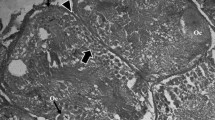Summary
The morphological features during development of diapause and non-diapause eggs of the silkworm,Bombyx mori, were investigated by means of light and electron microscopy, with special reference to eggs up to 24 h after oviposition.
The blastoderm and yolk cells began to be formed about 6 and 24 h after oviposition, respectively, in both the diapause and non-diapause eggs, indicating that the diapause and non-diapause eggs develop at similar rates at least until 24 h after oviposition.
Specific changes in the distribution of yolk granules were observed during early development of the diapause egg. Its yolk granules gradually aggregated into clusters from the periphery toward the inside of the egg during the period of blastoderm formation. Aggregation of yolk granules was most noticeable about 12 h after oviposition and then they dispersed again before yolk cell formation. On the other hand, yolk granules of the non-diapause eggs remained dispersed during development.
Similar content being viewed by others
References
Chino, H.: Carbohydrate metabolism in diapause egg of the silkworm,Bombyx mori. I. Diapause and the change of glycogen content. Embryologia3, 295–316 (1957)
Chino, H.: Carbohydrate of the silkworm,Bombyx mori. II. Conversion of glycogen into sorbitol and glycerol during diapause. J. Insect Physiol.2, 1–12 (1958)
Fukuda, S.: The production of the diapause eggs by transplanting the suboesophageal ganglion in the silkworm. Proc. Japan Acad.27, 676–677 (1951)
Fukuda, S.: Function of the pupal brain and suboesophageal ganglion in the production of non-diapause and diapause eggs in the silkworm. Annot. Zool. Jap.25, 149–155 (1952)
Hasegawa, K.: Studies on the voltinism in the silkworm,Bombyx mori L., with special reference to the organs concerning determination of voltinism (A preliminary note). Proc. Japan Acad.27, 667–671 (1951)
Hasegawa, K.: Studies on the voltinism in the silkworm,Bombyx mori, with special reference to the organs concerning determination of voltinism. J. Fac. Agric. Tottori Univ.1, 83–124 (1952)
Kai, H., Hasegawa, K.: An esterase in relation to yolk cell lysis at diapause termination in the silkworm,Bombyx mori. J. Insect Physiol.19, 799–810 (1973)
Krause, G., Krause, J.: Die Entwicklung prospektiver Diapause-Keime (Bombyx mori L.) in vitro ohne dormanz. I. Extrakte aus Diapause- oder Nondiapause-Eiern bestimmten Stadiums ohne oder mit Dotterdepot. Wilhelm Roux' Archiv167, 137–163 (1971)
Krause, G., Krause, J.: Die Entwicklung prospektiver Diapause-Keime (Bombyx mori L.) in vitro ohne Dormanz. II. Fremdeiweißmedium (LYS) mit extraembryonalem Depotmaterial aus verschiedenen Phasen der Eidiapause. Wilhelm Roux' Archiv171, 121–159 (1972)
Krause, G., Krause, J.: Die Entwicklung prospektiver Diapause-Keime (Bombyx mori L.) in vitro ohne Dormanz. III. Ihre Kompetenz und Interferenz in LYS-Medien ohne extraembryonales Depotmaterial. Wilhelm Roux' Archiv176, 125–150 (1974)
Miura, E.: Studies on the yolk cells in the diapausing, non-diapausing and artificial non-diapausing silkworm eggs (in Japanese). Bull. Kyoto Imp. Coll. Seric.1, 1–36 (1932)
Okada, M.: Electron microscope studies on diapause embryos of the silkworm,Bombyx mori L. Sc. Rep. T.K.D. Sect. B.14, 1–17 (1970)
Sabatini, D.D., Bensch, K., Barrnett, R.J.: Cytochemistry and electron microscopy: The preservation of cellular ultrastructure and enzymatic activity by aldehyde fixation. J. Cell Biol.17, 19–58 (1963)
Takei, R., Nagashima, E.: Electron-microscope investigation on the early developmental stages of diapause and non-diapause eggs in the silkworm,Bombyx mori L. (in Japanese). J. Sericult. Sci. Japan44, 118–124 (1975a)
Takei, R., Nagashima, E.: Electron-microscope investigation on the yolk granules in the silkworm egg (in Japanese). J. Sericult. Sci. Japan44, 161–164 (1975b)
Takesue, S., Keino, H., Endo, K.: The morphological changes of the diapause and non-diapause eggs of silkworms,Bombyx mori L. (in Japanese). Zool. Magazine80, 464–464 (1971)
Umeya, Y.: Preliminary note on experiments of ooplasm transfusion of silkworm eggs with special reference to the development of embryo. Proc. Japan Acad.13, 378–380 (1937)
Yamauchi, R., Yamada, E.: On purification of glutaraldehyde for electron microscopy. J. Electron Microscopy17, 83–83 (1968)
Author information
Authors and Affiliations
Rights and permissions
About this article
Cite this article
Takesue, S., Keino, H. & Endo, K. Studies on the yolk granules of the silkworm,Bombyx mori L.: The morphology of diapause and non-diapause eggs during early developmental stages. Wilhelm Roux' Archiv 180, 93–105 (1976). https://doi.org/10.1007/BF00848100
Received:
Accepted:
Issue Date:
DOI: https://doi.org/10.1007/BF00848100



